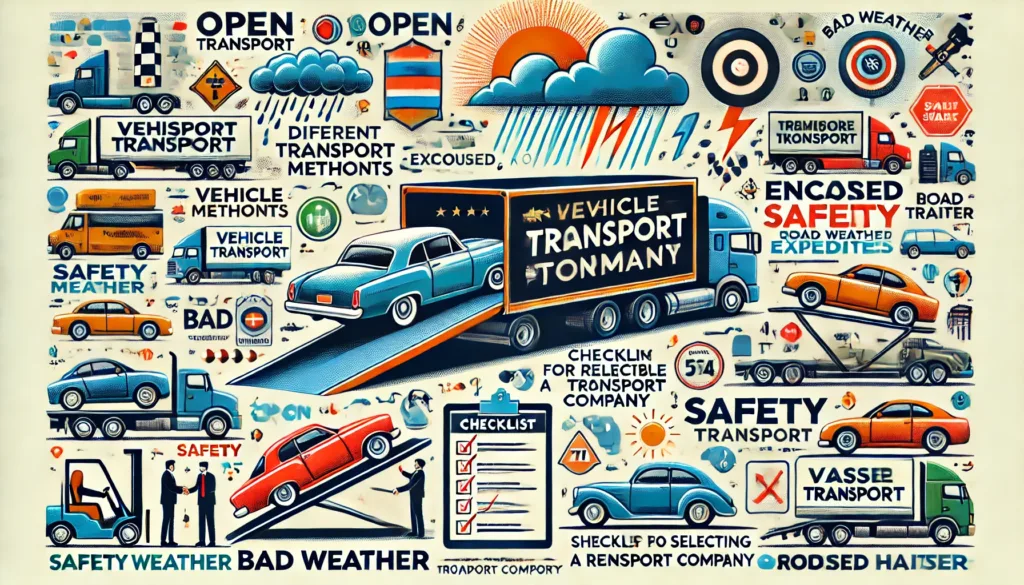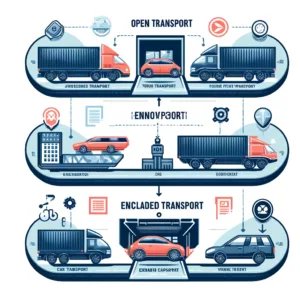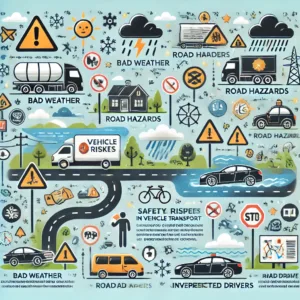
In today’s fast-paced world, vehicle transport information has become a vital resource for many individuals and businesses. Whether relocating to a new city, purchasing a car online, or shipping vehicles for a business, understanding the nuances of safe transport is essential. This guide aims to provide comprehensive vehicle transport information, ensuring that readers are well-informed about the best practices and strategies for a smooth shipping experience.
Safety in vehicle transport is not just a preference; it’s a necessity. From selecting a reliable transport company to understanding insurance options, each decision plays a crucial role in protecting your valuable asset. With countless websites in the car shipping industry, it can be overwhelming to determine which provider offers the best services. However, at Navi Auto Transport, we are committed to delivering the absolute cream of the crop, ensuring your vehicle is in the best hands throughout the transport process.
Summary
What is Vehicle Transport?
Vehicle transport information encompasses the various methods and services involved in moving vehicles from one location to another. This service is essential for individuals and businesses alike, whether relocating, purchasing a vehicle online, or managing a fleet of cars. Understanding the concept of vehicle transport is the first step in ensuring that your vehicle reaches its destination safely and efficiently.
Types of Vehicle Transport Services
When it comes to vehicle transport, several methods cater to specific requirements and preferences:
- Open Transport
Open transport is the most common and economical method for transporting vehicles. In this method, vehicles are loaded onto an open trailer, exposed to the elements but capable of accommodating multiple cars simultaneously. This option is ideal for standard vehicles and provides a cost-effective solution for many customers. - Enclosed Transport
Enclosed transport offers a higher level of protection for vehicles, particularly for luxury, classic, or vintage cars. Vehicles are loaded into a fully enclosed trailer, shielding them from weather conditions, road debris, and potential damage during transport. This service typically comes at a premium but ensures maximum safety for high-value assets. - Terminal-to-Terminal Services
In terminal-to-terminal services, vehicles are dropped off and picked up at designated terminals rather than being delivered directly to the owner’s doorstep. While this option may save on transport costs, it requires more coordination and may involve additional waiting times. - Expedited Car Transport
Expedited car transport is designed for those who need their vehicle moved quickly. This service prioritizes speed and efficiency, ensuring that your vehicle is transported as swiftly as possible. While this option may incur higher costs, it is ideal for situations where time is of the essence, such as emergency relocations or last-minute purchases.

Why Safe Car Transport Matters
Safety Risks in Vehicle Transport
When discussing vehicle transport information, safety should always be a top priority. Numerous risks can arise during the transportation process, which may compromise the integrity of your vehicle. Potential safety risks include:
- Weather Conditions: Inclement weather, such as heavy rain or snow, can create hazardous driving conditions for transport carriers, potentially leading to accidents or delays.
- Road Hazards: Potholes, debris, and uneven road surfaces can cause damage to vehicles if transport carriers are not vigilant or properly equipped to handle such challenges.
- Inexperienced Drivers: Choosing a transport company with inexperienced drivers can increase the risk of accidents or improper handling of vehicles during loading and unloading.
Recognizing these risks is crucial for vehicle owners to take the necessary precautions when selecting a transport service.
Impact of Poor Transport on Vehicle Condition
The condition of your vehicle upon arrival can be severely affected by poor transport practices. Common issues that may arise include:
- Exterior Damage: Scratches, dents, or paint chips can occur if vehicles are not secured properly during transport, particularly in open transport settings.
- Mechanical Problems: Improper handling during loading and unloading can lead to mechanical issues that may not be immediately apparent, affecting the vehicle’s performance.
- Loss of Value: Damage incurred during transport can significantly reduce the vehicle’s resale value. For luxury and classic cars, maintaining pristine condition is essential to preserving value.
Factors to Consider for Safe Vehicle Transport
Choosing a Reliable Transport Company
When it comes to vehicle transport information, selecting the right transport company is crucial for ensuring the safe transport of your vehicle. Here are some key criteria to consider:
- Reputation and Reviews: Research customer reviews and ratings on platforms like Google, Yelp, or the Better Business Bureau (BBB). A strong reputation indicates reliability and professionalism.
- Insurance Coverage: Ensure the company offers adequate insurance coverage for your vehicle during transport. This protection is vital in case of unforeseen accidents or damage.
- Experience and Credentials: Look for companies with a proven track record in the industry. Verify their licenses and certifications to ensure they meet regulatory requirements.
- Customer Service: A responsive and knowledgeable customer service team can provide peace of mind throughout the transport process. They should be available to address any concerns or questions you may have.
Understanding Transport Insurance
Transport insurance is a crucial aspect of vehicle transport information that many customers overlook. Understanding the various options available can help protect your investment:
- Basic Coverage: Most transport companies offer basic liability coverage, which may only cover a portion of the vehicle’s value. Be sure to inquire about the specifics of this coverage.
- Full Coverage Options: Consider purchasing additional insurance for comprehensive protection. This coverage typically includes damage caused by accidents, theft, or natural disasters during transport.
- Exclusions: Familiarize yourself with any exclusions in the insurance policy. Certain items, such as personal belongings inside the vehicle, may not be covered, so it’s essential to remove valuables before transport.
Case Study: Successful Vehicle Transport Experience
A classic car enthusiast who needed to transport a rare 1970 Chevrolet Camaro from California to Florida. The owner was understandably concerned about potential damage during transit, given the car’s vintage status and significant value.
The Transport Process:
The owner researched various transport companies and ultimately chose a reputable provider specializing in enclosed transport services. This decision was primarily influenced by the company’s strong customer reviews and comprehensive insurance coverage.
The transport company took several steps to ensure the Camaro’s safety:
- Inspection and Documentation: Prior to loading, the company conducted a thorough inspection of the vehicle and documented its condition with detailed photographs.
- Secure Loading: The Camaro was carefully loaded into a custom-fitted enclosed trailer, securing it with high-quality straps to prevent movement during transit.
- Real-time Tracking: Throughout the journey, the owner was provided with real-time tracking updates, allowing them to stay informed about the car’s location and estimated arrival time.
Successful Outcome:
Upon arrival, the vehicle was in pristine condition, with no signs of damage or wear. The owner was thrilled with the service provided and noted the importance of choosing a qualified transport company to ensure the safety of their investment. This experience exemplifies how selecting a reputable transport service can lead to a successful and stress-free vehicle transport experience.
How to Solve Common Issues in Vehicle Transport
Identifying Common Problems
When it comes to vehicle transport information, it’s essential to recognize that even with careful planning, various issues can arise during the transport process. Understanding these challenges is key for both vehicle owners and transport providers. Some common problems include:
- Delays in Transport: Unexpected delays can occur due to various factors, including traffic, weather conditions, or logistical challenges. These delays can lead to frustration for vehicle owners who need timely delivery.
- Damage During Transport: Accidents can happen, resulting in scratches, dents, or other damage to the vehicle. This risk is particularly pertinent in open transport methods.
- Miscommunication: Inadequate communication between the transport company and the vehicle owner can lead to misunderstandings regarding pickup and delivery times or locations.
Effective Solutions and Examples
Addressing these common issues requires proactive measures and effective communication strategies. Here are some solutions:
- Proactive Communication: Transport companies should maintain open lines of communication with clients. Providing regular updates on the transport status, including any potential delays, can significantly reduce anxiety and build trust.
- Damage Prevention Strategies: To minimize the risk of damage, companies can implement additional safety measures, such as using padded straps and ensuring vehicles are loaded in a manner that prevents movement during transit.
- Flexible Scheduling: Offering flexible pickup and delivery options can help accommodate unexpected changes. For example, if a delay occurs, having multiple drop-off locations can provide alternative solutions for timely delivery.
- Thorough Pre-Transport Inspections: Conducting detailed inspections before transport can help identify existing issues, preventing disputes over damage upon arrival. This practice should include both photographic documentation and written reports.
